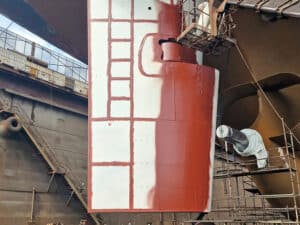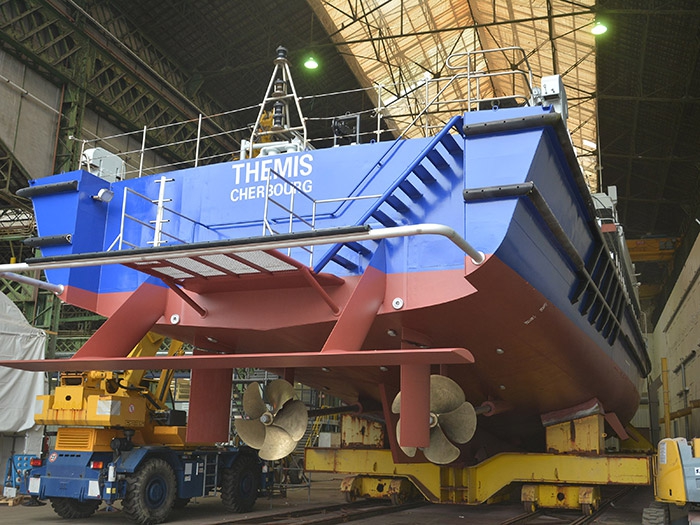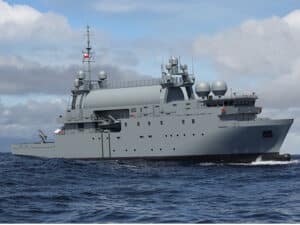
VIDEO: Hull Vane retrofit dramatically boosts French OPV’s performance
Written by Nick Blenkey
Hull Vane fitted on Themis
JULY 12 2018 — The French Coastguard (Affaires Maritimes) Offshore Patrol Vessel (OPV) Thémis has become the first vessel in France to be be given a hydrodynamic upgrade by retrofitting it with the Hull Vane, an underwater wing that reduces the vessel’s resistance.
The retrofit was carried out by the CMN Shipyard in Cherbourg and sea trials conducted by the yard last month showed some impressive improvements in performance. Comparison with the benchmark sea trials – conducted in January in exactly the same conditions – by CMN’s sea trial team showed a reduction in fuel consumption of 18% at 12 knots, 27% at 15 knots and 22% at 20 knots. The top speed increased from 19.7 knots to 21 knots.
“When we came across the Hull Vane technology, we saw it as a very simple and effective way to improve the performance of our naval and coastguard vessels,” says Yves Rouillé, Senior Naval architect at CMN. “We initially conducted a study with Hull Vane on one of our series, the CL52 Vigilante, which is representative of many OPVs we have built over the years. Through the use of Computational Fluid Dynamics (CFD), an excellent savings potential was demonstrated over the entire speed range. We then proposed the solution jointly with Hull Vane BV to one of our clients, the Affaires Maritimes, which is a dependency of the Ministry of the Environment.”
“We were very impressed with the fact that CMN, twelve years after delivery, still put so much effort in optimizing the ship they built,” says Pascal Brantonne, technical superintendent of the Affaires Maritimes. “We are very satisfied with this vessel, and we even have crew who drive to Cherbourg all the way from the South of France because it’s the favorite vessel in our fleet. So it was important that the ship should improve in all ways. An important part of the decision was that the Hull Vane also improves the ship motions in waves, as we frequently sail in rough seas. This will certainly be appreciated by the crew.”
After the order for the Hull Vane was received by Wageningen, Netherlands, based Hull Vane BV, the device was specifically optimized by Hull Vane BV for the Thémis, which differs from the standard CL52, however the results were very similar.
“The Hull Vane is basically a patented application of a hydrofoil on ships where you wouldn’t expect one: steel and aluminum vessels which operate in the area between full displacement and planing mode, what we call fast displacement vessels,” says Bruno Bouckaert, sales director of Hull Vane BV. “It works by creating a lift force from the upward flow at the stern. This lift force is angled forward and therefore not only lifts the vessel, but also pushes it forward. The Hull Vane also reduces the stern wave, which is a form of energy loss, which we try to minimize.”
The Hull Vane for Thémis is the eleventh unit built, but is the first retrofitted on an Offshore Patrol Vessel, a ship type that Hull Vane BV expects to become one of its major markets. About a dozen studies and model tests have indicated similar savings percentages on patrol vessels, ranging from 25 m to 108 m.
The Hull Vane was built of steel in the Netherlands and was transported to Cherbourg by truck. CMN was in charge of the installation and the structural integration, including a lengthening of the divers’ platform.
The influence of the Hull Vane can be clearly seen in the modification of the wake behind the vessel, as shown in the images below, which show the wake before retrofit on the left, and after retrofit on the right. The results match very closely the performance predicted in CFD, by Hull Vane BV’s sister company Van Oossanen Fluid Dynamics. Model tests were not done for this project to save on costs and time.
Wave profile at 15 knots without Hull Vane (left) and with Hull Vane (right)

Thémis has a top speed of 21 knots, but most of the time she sails around 12 knots to save fuel. Taking into account the operational profile of the vessel, the annual savings amount to 20% of the fuel consumption, and of course the same percentage in emissions of CO2, particulate matter, NOx and SOx.
Pascal Brantonne adds: “We aim at reducing the greenhouse gas emissions of our fleet. The easiest way is to sail less or slower, but we already do so. If we would do it more, we would need more ships to carry out the same tasks. The challenge now is to find technical solutions which significantly reduce our emissions, and the Hull Vane is certainly one of them. Moreover, it’s one that pays for itself by reducing our fuel costs. The cooperation with CMN and Hull Vane has been very pleasant and all our concerns were adequately addressed. We look forward to many years ahead on the Thémis.”





Leave a Reply
You must be logged in to post a comment.